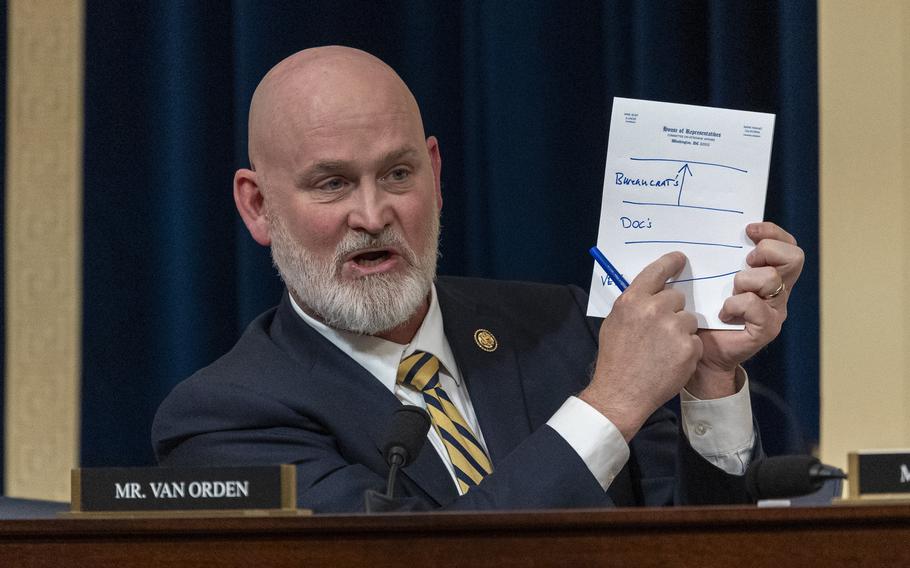
Secretary of the VA Doug Collins testifies May 15, 2025, in Washington during a hearing of the House VA Committee. VA Secretary Doug Collins delivered a frank assessment to lawmakers of his vision for restructuring the federal government’s second-largest department to align with President Donald Trump's order in February for a sweeping downsizing of the federal government. (Eric Kayne/Stars and Stripes)
WASHINGTON — Department of Veterans Affairs Secretary Doug Collins on Thursday delivered a candid assessment to House lawmakers of his vision for restructuring the second-largest federal agency to align with President Donald Trump’s order to downsize the government.
Collins said he is now conducting a sweeping review of the VA with the goal to eliminate non-essential roles, cut unnecessary overhead and strategically reduce staff while improving veterans services.
But Democratic and Republican lawmakers had different reactions to the VA secretary’s testimony during the contentious four-hour hearing of the House Veterans’ Affairs Committee.
The hearing, which focused on the VA budget for fiscal 2026, was Collins’ first formal meeting with the committee since assuming the top job at the VA three months ago.
“You’ve not earned our trust, at least not yet,” said Rep. Mark Takano of California, the top Democrat on the committee, who rebuked Collins for not personally reaching out to Democratic lawmakers since taking office 99 days ago.
“I look forward to Secretary Collins’ efforts to restore transparency and accountability — because that makes VA work better — and I know he shares that goal,’’ said Rep. Mike Bost, R-Ill., chairman of the committee.
Collins did not present a complete budget. Instead, he provided an overview for ending “waste and bureaucracy’‘ through staff reductions. He offered early plans to centralize payroll and human resource services, which are now handled at dozens of offices across the VA system.
Collins also suggested a likely target for future staff cuts is underperforming administrators at VA headquarters in Washington, which is the office where he works.
“We have 16,375 [workers] in the central office — many who are not doing policy, doing other things. They actually are not showing up” for work at the office, he said.
Rep. Derrick Van Orden, R-Wis., interrupted Collins and asked him to repeat his statement “just so people can understand the scope of this, the ludicrousness of this bureaucracy.”

Rep. Derrick Van Orden, R-Wis., holds up paper with notes written on it during a hearing of the House Veterans’ Affairs Committee on May 15, 2025. VA Secretary Doug Collins told lawmakers of his vision for restructuring the VA to align with President Donald Trump’s order for a sweeping downsizing of the federal government. (Eric Kayne/Stars and Stripes)
But Collins also expressed support for a variety of popular VA health initiatives, including non-VA community care and funding the Elizabeth Dole Act that supports at-home care for severely disabled veterans.
Preliminary details released in the VA’s 2026 budget show a 4% increase for health care programs. But the VA is also a target for significant staffing cuts expected in the summer, according to an internal VA memo publicized in March.
“VA is in need of reform. We must do a better job delivering timely care to veterans, getting to ‘yes’ so veterans can get the benefits they’ve earned, and making sure the money Congress appropriates to VA is not diverted to non-mission-critical or even wasteful programs,’’ Collins said.
But Rep. Julia Brownley, D-Calif., questioned why VA supervisors were asked to sign nondisclosure statements and why spyware was installed on some staff computers.
Collins said it is necessary to monitor office communications to ‘‘keep sensitive information internal” as he develops a reorganization plan for the agency.
But he assured Brownley that whistleblowers’ confidential disclosures are protected under the nondisclosure agreement if staff members report concerns about malfeasance at the agency.
Collins also responded to numerous questions on whether he plans to cut frontline staff who work directly with veterans to deliver benefits and health services.
“We’re going to maintain VA’s mission-essential jobs like doctors, nurses and claims processors,’‘ he said.
Collins also criticized Democratic senators for blocking a confirmation vote for veterans nominated to take on the key VA leadership positions of the chief financial officer, general counsel and undersecretary for memorial affairs.
He said the delay is hampering his work at the agency.
“I’ve told the senators this, if you want to hire veterans, I’ve got three of them that need to be approved and I need to get them on the job working for our veterans,’’ Collins said.
Approximately 25% of VA jobs are held by veterans.

Department of Veterans Affairs Secretary Doug Collins, left, testifies May 15, 2025, during a hearing of the House Veterans’ Affairs Committee. (Eric Kayne/Stars and Stripes)
Rep. Tim Kennedy, D-N.Y., was among several Democrats who tried to get Collins to provide information on planned workforce reductions. Kennedy referred to statements by VA Chief of Staff Christopher Syrek in a leaked memo directing agency leaders to submit plans to reorganize the VA through a major staff downsizing that could affect up to 83,000 workers by August.
“Now I’ve asked this question repeatedly of this administration but still haven’t received a clear answer. How do you plan to reduce staff without affecting care? Who exactly are you planning to let go? What are their roles?” Kennedy asked.
But Collins disclosed little about the planning process underway. He said the employees to be affected by workforce reductions will be informed in advance of personnel changes.
“There’s no such thing as a sudden firing. This is a process, and as we get to the level of where we see what our new structure looks like, [employees] will know how we’re going to be rolling this out,” Collins said. “There’s going to be notice to the employees.”